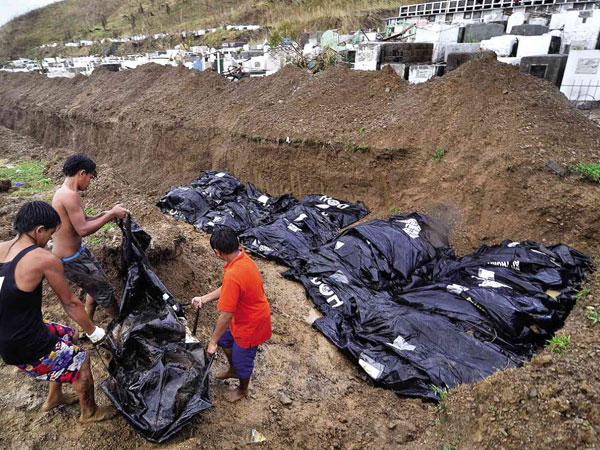
MASS BURIAL Policemen and volunteers bury some 100 bodies in a mass grave in the Tacloban City public cemetery on Thursday. RICHARD A. REYES
TACLOBAN CITY—Workers in this typhoon-shattered city buried 100 of its thousands of dead in a hillside mass burial on Thursday.
Authorities say 2,357 people have been confirmed dead in the disaster, but that figure is expected to rise, perhaps significantly, when information is collected from other areas of the disaster zone.
In the city’s first mass burial, 100 bodies in leaking black bags were lowered into graves without any prayers being said.
John Cajipe, 31, and three teenage boys who work at the local cemetery placed the first body in the grave’s right hand corner. Sweat rolled down their faces in the blistering sun as they carried the body.
The second body followed two minutes later, carefully placed alongside the first. And so on, until scores of bodies—all unidentifed—filled the grave.
“I hope this is the last time I see something like this,” said Mayor Alfred Romualdez. “When I look at this, it just reminds me of what has happened from the day the storm hit until today.”
Officials said efforts had been made to identify the bodies so families have a chance of finding out what happened to their loved ones in the days and weeks to come. It was not immediately clear whether this included DNA testing.
Days after President Aquino told CNN that the death toll from Supertyphoon “Yolanda” (international name: Haiyan) may only be about 2,500 in the entire Visayas region, a senior city government official on Thursday said the deaths in Tacloban alone might reach 10,000.
John Tecson Lim, the city administrator, said bloated bodies were still being recovered in different parts of the coastal city as the Department of Health (DOH) and the local government started the mass burial of the 300 recovered typhoon victims.
He said personnel of the Metropolitan Manila Development Authority (MMDA) found 37 bodies when they cleared a park in front of the ruined city hall on Tuesday.
“Easily, the estimate (of the death toll) in Tacloban alone is 10,000 after this is done and over with,” Lim told reporters, confirming initial estimates that Aquino downplayed in his interview with CNN’s Christiane Amanpour on Wednesday. The President said the figure was “too much.”
“I think that’s even a conservative estimate,” Lim said, noting that thousands of bodies could be still under the rubble of collapsed houses and buildings.
He said it was also possible that more bodies had sunk deep into the sea after being washed away when storm surges several meters high inundated coastal villages.
As agreed by DOH and local officials, Lim said the bodies would be buried at the Basper Cemetery.
“As allowed by the DOH, the bodies will be buried side by side in a two-level pile. We will make sure that these would be properly buried and (marked),” he said.
All the bodies, most of them already decomposing, had yet to be identified, he said.
Another mass grave would be prepared in a lot owned by the city government in Barangay (village) Abucay, which can accommodate thousands, according to Lim.
Health Undersecretary Janet Garin, a native of Tacloban, said it took some time for the department to retrieve the bodies after Secretary Enrique Ona deemed it best for the DOH to attend first to the medical needs of the survivors.
“Our shipment of body bags was bumped off as the DOH prioritized the delivery of medicines, antibiotics and materials for surgery,” Garin told the Inquirer.
Dr. Emmanuel Bueno, medical director of Amang Rodriguez Memorial Medical Hospital, said the DOH would take pictures of the bodies and take DNA samples to help their relatives identify them later on.
“Secretary Ona ordered us to bury the bodies in a decent burial ground,” he said.
Almost 200 corpses—many of them unidentified—were lined up side by side outside the city hall almost a week after one of the most powerful typhoons ever to make landfall smashed through central Philippines.
“There are still so many bodies in so many areas. It’s scary,” Romualdez said, adding that retrieval teams were struggling to cope.
He said the people of Tacloban needed an “overwhelming response” from aid organizations and the government.
“We need more manpower and more equipment,” Romualdez pleaded.
“I cannot use a truck to collect corpses in the morning and then use it to distribute relief goods in the afternoon,” he added.
“Let’s get the bodies off the streets. They are creating an atmosphere of fear and depression.”
Romualdez said the bodies lying on the grass outside city hall were waiting for the military to transport them to the two burial sites—one for the identified and one for those whose names were not known.
The central government blamed the halt in corpse collection on a lack of body bags, but insisted on Wednesday that the operation would accelerate.—With reports from AP, AFP and Frances Mangosing, INQUIRER.net
RELATED STORIES:
Tacloban buries some dead as ‘Yolanda’ survivors beg for help
More than half of 2,357 deaths come from Leyte, Samar – NDRRMC
Updated list of unaccounted persons in Samar, Leyte

